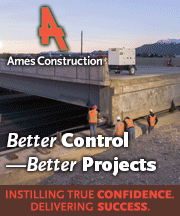
2015 Excellence in Engineering Award Winner: I-485/I-85 Charlotte Interchange
Issue 4 of 2015
The improvement of the Charlotte, N.C. I-485 Outer Loop was a much anticipated upgrade for the city’s overwhelmed transportation network. As one of the fastest growing cities in the country, Charlotte was undergoing extensive improvements to its transportation system, the last vital link of which was the upgrade of the I-485/I-85 Interchange. Two adjacent projects, the widening of I-85 to the northeast and the new alignment construction of I-485 to the northwest, were under design-build development concurrently, necessitating extensive coordination to make the precise geometric connections between the three projects. To tackle these challenges the owner turned to design-build and, as a result, capitalized on benefits that could only have been realized through the innovative delivery method.
“If not for design-build, the project may not have advanced as it did,” said James Avitabile, P.E., DBIA, while discussing his reasons for supporting the project’s nomination for Excellence in Engineering. “The design-build team used a high degree of innovation to develop a new interchange layout that improved traffic operations and level of service, reduced the structure height and improved aesthetics. While achieving each of these benefits, the overall cost was reduced and the North Carolina DOT was pleased with the results. A project outcome like this is exactly what design-build is all about.” Avitabile was a member of this year’s awards jury and is the Strategic Initiatives Leader at RS&H.
Though the original planning document had called for the construction of a four-level stack interchange with ramps, loops and two massive flyovers, the design-build team of Lane Construction Corporation (Lane) and STV/Ralph Whitehead Associates (STV) added value to both their bid and the project design by collaboratively developing an Alternative Technical Concept (ATC) during the pre-award phase. They worked remarkably fast to develop an entire year’s worth of engineering in just two months. Instead of the four-level stack, the team proposed a two-level turbine interchange, eliminating the flyovers and the necessity for over 200,000 truckloads of dirt to be hauled for the construction of embankments. The resultant cost savings for this ATC was estimated at an impressive $30 million.
The original design was not only more expensive, but posed some onerous safety concerns that were mitigated by the design-build team’s redesign. Redrawing the design allowed work to be transitioned away from close proximity to live traffic in a way that would have been impossible under the original layout. Bolstered by project-specific training and weekly tool-box safety meetings, the project boasted an excellent safety record.
Despite the threat of delay after redesigning the original plans, the I-485/I-85 interchange was delivered on time and under budget and will leave its mark on Charlotte’s transportation network for years to come. Built with precast and prestressed bridge girders instead of structural steel, the interchange is as sustainable as it is innovative. And, as the first North Carolina Department of Transportation (NCDOT) design-build project to allow ATCs, the success of the project has “convinced the NCDOT to institutionalize the use of ATCs in future design-build contracts, rendering tens of millions of dollars in savings on subsequent projects,” according to Rodger Rochelle of NCDOT. “We are proud to have successfully partnered with [Lane-STV] on this and many other successful transportation facilities in this wonderful state.”
<< Owner Scholarship Due Date | Project of the Year Highlight >>
Related Stories:
2015 Merit Award Winners: Transportation Category








